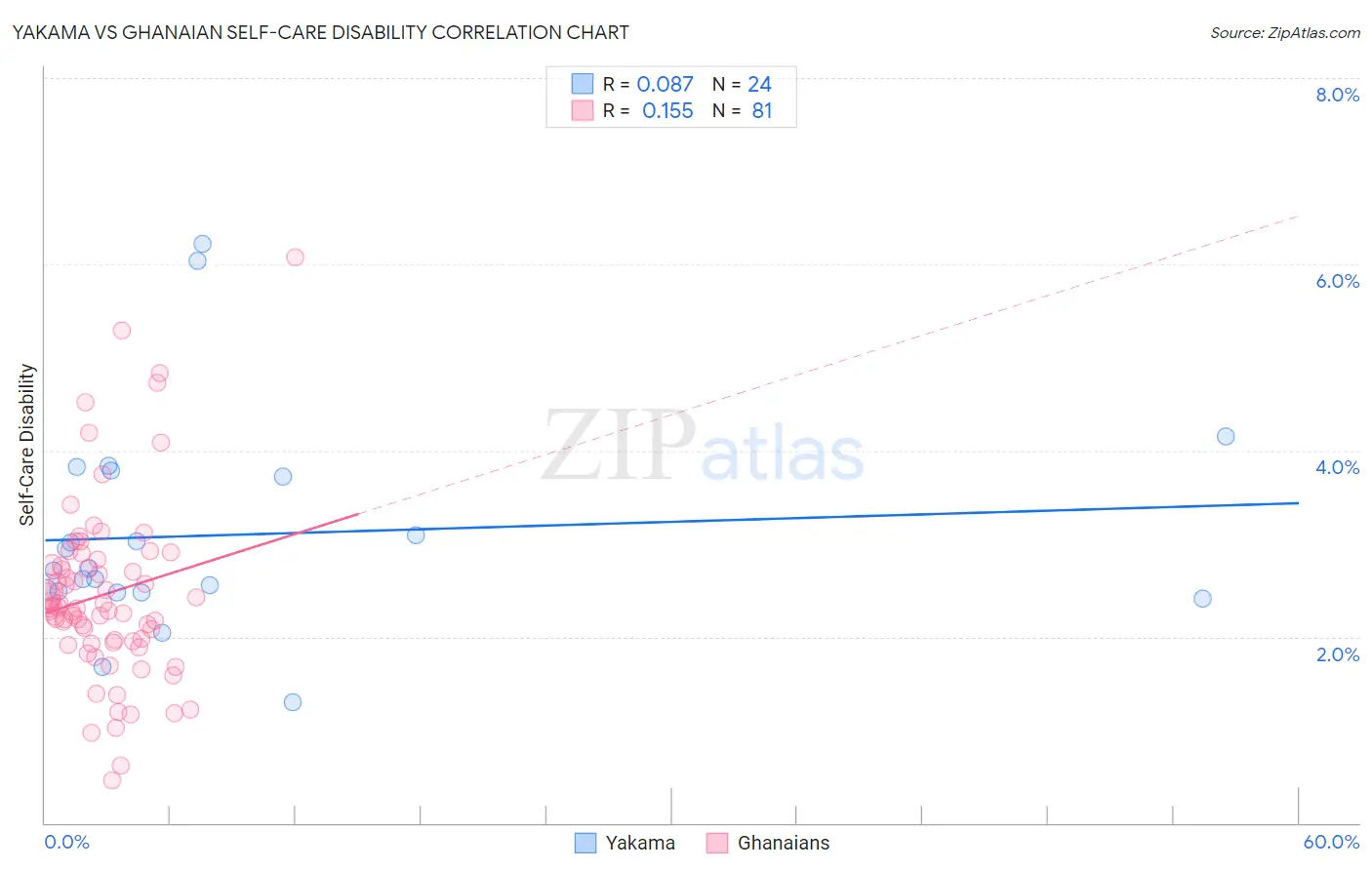Yakama vs Ghanaian Self-Care Disability
COMPARE
Yakama
Ghanaian
Self-Care Disability
Self-Care Disability Comparison
Yakama
Ghanaians
2.7%
SELF-CARE DISABILITY
0.1/ 100
METRIC RATING
274th/ 347
METRIC RANK
2.5%
SELF-CARE DISABILITY
40.4/ 100
METRIC RATING
181st/ 347
METRIC RANK
Yakama vs Ghanaian Self-Care Disability Correlation Chart
The statistical analysis conducted on geographies consisting of 19,914,398 people shows a slight positive correlation between the proportion of Yakama and percentage of population with self-care disability in the United States with a correlation coefficient (R) of 0.087 and weighted average of 2.7%. Similarly, the statistical analysis conducted on geographies consisting of 190,499,518 people shows a poor positive correlation between the proportion of Ghanaians and percentage of population with self-care disability in the United States with a correlation coefficient (R) of 0.155 and weighted average of 2.5%, a difference of 8.1%.

Self-Care Disability Correlation Summary
| Measurement | Yakama | Ghanaian |
| Minimum | 1.3% | 0.46% |
| Maximum | 6.2% | 6.1% |
| Range | 4.9% | 5.6% |
| Mean | 3.1% | 2.5% |
| Median | 2.7% | 2.3% |
| Interquartile 25% (IQ1) | 2.5% | 1.9% |
| Interquartile 75% (IQ3) | 3.8% | 2.8% |
| Interquartile Range (IQR) | 1.3% | 0.86% |
| Standard Deviation (Sample) | 1.2% | 0.97% |
| Standard Deviation (Population) | 1.1% | 0.97% |
Similar Demographics by Self-Care Disability
Demographics Similar to Yakama by Self-Care Disability
In terms of self-care disability, the demographic groups most similar to Yakama are Immigrants from Trinidad and Tobago (2.7%, a difference of 0.0%), Mexican (2.7%, a difference of 0.060%), Japanese (2.7%, a difference of 0.13%), Immigrants from Ukraine (2.7%, a difference of 0.19%), and Immigrants from Laos (2.7%, a difference of 0.20%).
| Demographics | Rating | Rank | Self-Care Disability |
| Yaqui | 0.1 /100 | #267 | Tragic 2.7% |
| Immigrants | Mexico | 0.1 /100 | #268 | Tragic 2.7% |
| U.S. Virgin Islanders | 0.1 /100 | #269 | Tragic 2.7% |
| Immigrants | Micronesia | 0.1 /100 | #270 | Tragic 2.7% |
| Trinidadians and Tobagonians | 0.1 /100 | #271 | Tragic 2.7% |
| Immigrants | Laos | 0.1 /100 | #272 | Tragic 2.7% |
| Mexicans | 0.1 /100 | #273 | Tragic 2.7% |
| Yakama | 0.1 /100 | #274 | Tragic 2.7% |
| Immigrants | Trinidad and Tobago | 0.1 /100 | #275 | Tragic 2.7% |
| Japanese | 0.1 /100 | #276 | Tragic 2.7% |
| Immigrants | Ukraine | 0.1 /100 | #277 | Tragic 2.7% |
| Ottawa | 0.1 /100 | #278 | Tragic 2.7% |
| Iroquois | 0.1 /100 | #279 | Tragic 2.7% |
| Hispanics or Latinos | 0.1 /100 | #280 | Tragic 2.7% |
| Immigrants | Iraq | 0.0 /100 | #281 | Tragic 2.7% |
Demographics Similar to Ghanaians by Self-Care Disability
In terms of self-care disability, the demographic groups most similar to Ghanaians are Indonesian (2.5%, a difference of 0.040%), Maltese (2.5%, a difference of 0.14%), Salvadoran (2.5%, a difference of 0.20%), Yugoslavian (2.5%, a difference of 0.21%), and Hungarian (2.5%, a difference of 0.25%).
| Demographics | Rating | Rank | Self-Care Disability |
| Welsh | 50.0 /100 | #174 | Average 2.5% |
| Immigrants | Bosnia and Herzegovina | 49.6 /100 | #175 | Average 2.5% |
| Immigrants | Afghanistan | 47.6 /100 | #176 | Average 2.5% |
| Immigrants | Kazakhstan | 46.7 /100 | #177 | Average 2.5% |
| English | 46.2 /100 | #178 | Average 2.5% |
| Hungarians | 45.5 /100 | #179 | Average 2.5% |
| Indonesians | 41.2 /100 | #180 | Average 2.5% |
| Ghanaians | 40.4 /100 | #181 | Average 2.5% |
| Maltese | 37.5 /100 | #182 | Fair 2.5% |
| Salvadorans | 36.4 /100 | #183 | Fair 2.5% |
| Yugoslavians | 36.1 /100 | #184 | Fair 2.5% |
| Slavs | 34.3 /100 | #185 | Fair 2.5% |
| Immigrants | El Salvador | 33.0 /100 | #186 | Fair 2.5% |
| Irish | 28.7 /100 | #187 | Fair 2.5% |
| Immigrants | Oceania | 28.3 /100 | #188 | Fair 2.5% |